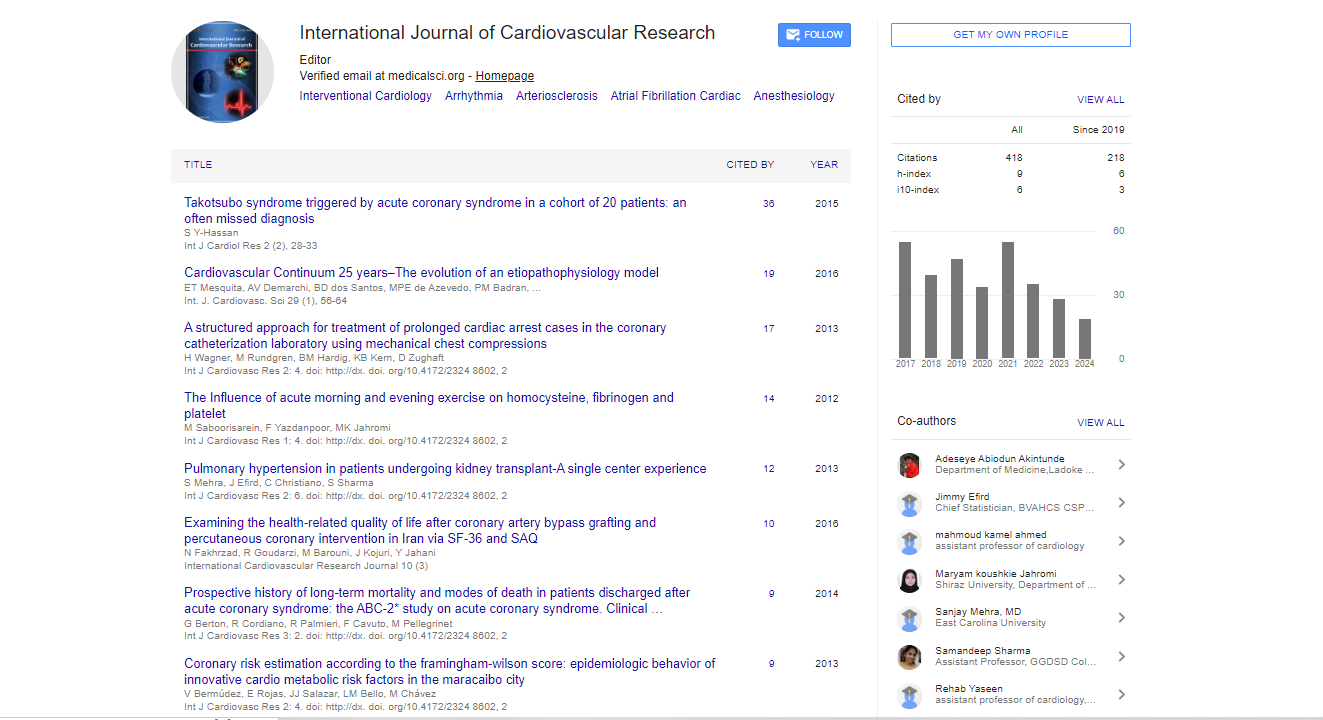Perspective, Int J Cardiol Res Vol: 13 Issue: 6
Immune Modulation and Impact of Inflammation in Heart Disease
Min-Joon Kim*
1Department of Cardiology, Seoul National University Hospital, Seoul, South Korea
*Corresponding Author: Min-Joon Kim,
Department of Cardiology, Seoul National
University Hospital, Seoul, South Korea
E-mail: minjoon.kim@snu.ac.kr
Received date: 28 November, 2024 Manuscript No. ICRJ-24-156844;
Editor assigned date: 02 December, 2024, PreQC No. ICRJ-24-156844 (PQ);
Reviewed date: 16 December, 2024, QC No. ICRJ-24-156844;
Revised date: 23 December, 2024, Manuscript No. ICRJ-24-156844 (R);
Published date: 30 December, 2024, DOI: 10.4172/2324-8602.1000596.
Citation: Kim M J (2024) Personalized Nutrition in Preventing and Managing Heart Disease. Int J Cardiol Res 13:6.
Description
The human heart is not only a mechanical pump that maintains circulatory homeostasis but also a biological entity susceptible to a range of inflammatory and immune-mediated processes. Cardiovascular Diseases (CVDs), particularly atherosclerosis, myocardial infarction and heart failure, are among the leading causes of morbidity and mortality globally. Understanding the complex relation between the immune system and cardiovascular health offers potential avenues for targeted therapies and preventive strategies. Inflammation is a blessing and a curse in cardiovascular health. While it is an essential defense mechanism against pathogens and tissue injury, chronic inflammation is implicated in the development and progression of heart disease. Inflammatory markers, such as C-Reactive Protein (CRP) and Interleukin-6 (IL-6), have been identified as predictors of cardiovascular events. These markers often indicate an ongoing lowgrade systemic inflammatory response, which can affect the basic cause of cardiac pathology. Atherosclerosis, the indication of many cardiovascular conditions, increases the inflammatory basis of heart disease. It begins with endothelial dysfunction, often triggered by traditional risk factors such as hypertension, hyperlipidemia and smoking. Endothelial injury promotes the recruitment of monocytes and T cells, which migrate into the subendothelial space and differentiate into macrophages. These macrophages engulf oxidized Low-Density Lipoproteins (ox-LDL), forming foam cells that contribute to plaque formation. Over time, this localized inflammation progresses, destabilizing plaques and predisposing them to rupture, leading to acute coronary syndromes.
Innate immunity serves as the first line of defense and includes physical barriers, cellular components and soluble factors. Pattern Recognition Receptors (PRRs) such as Toll-Like Receptors (TLRs) detect Pathogen-Associated Molecular Patterns (PAMPs) and Damage-Associated Molecular Patterns (DAMPs). In heart disease, DAMPs like heat shock proteins and mitochondrial DNA released during cellular stress activate TLRs, triggering pro-inflammatory cytokine production. Neutrophils and macrophages dominate the early stages of inflammation, releasing Reactive Oxygen Species (ROS) and proteolytic enzymes that intensify tissue damage. The adaptive immune response is more specific and involves T and B lymphocytes. In atherosclerosis, T cells recognize antigens presented by dendritic cells and secrete cytokines that modulate inflammation. For example, Th1 cells produce interferon-γ, which amplifies macrophage activation, while regulatory T cells (Tregs) suppress excessive immune responses to reduce tissue damage. B cells contribute by producing antibodies against ox-LDL and other modified self-antigens, which can either promote or resolve inflammation depending on the context. Acute Myocardial Infarction (AMI) is a classic example of how inflammation drives cardiac injury and repair. Following ischemic injury, necrotic cardiomyocytes release DAMPs that activate PRRs on resident immune cells, initiating an inflammatory cascade. Neutrophils are among the first responders, releasing ROS and proteolytic enzymes to clear dead cells but also inadvertently damaging surrounding viable myocardium. Macrophages subsequently infiltrate, transitioning from a pro-inflammatory M1 phenotype to a reparative M2 phenotype to facilitate tissue healing and scar formation. However, excessive or prolonged inflammation can impair healing and lead to adverse remodeling, increasing the risk of heart failure. Clinical studies have shown that elevated levels of inflammatory markers post-MI are associated with worse outcomes, emphasizing the need for therapies that balance inflammation and repair. Heart Failure, whether with reduced Ejection Fraction (HFrEF) or preserved Ejection Fraction (HFpEF), is increasingly recognized as a condition influenced by systemic inflammation. In HFrEF, chronic activation of the innate immune system perpetuates myocardial injury and fibrosis. Elevated levels of Tumor Necrosis Factor-α (TNF-α), IL-6 and other cytokines correlate with disease severity and prognosis.
Conclusion
Inflammation and the immune system are central to the pathogenesis of heart disease, influencing its onset, progression and outcomes. While they are indispensable for maintaining cardiovascular health, dysregulated immune responses contribute to a spectrum of cardiac conditions. Harnessing the power of immunomodulation offers exciting possibilities for transforming the management of heart disease. However, achieving this requires a detailed understanding of the immune cardiovascular axis and a commitment to translating basic study into clinical practice. By addressing these challenges, we can clear the path for innovative therapies that improve cardiovascular outcomes and enhance the quality of life for millions of patients worldwide.
 Spanish
Spanish  Chinese
Chinese  Russian
Russian  German
German  French
French  Japanese
Japanese  Portuguese
Portuguese  Hindi
Hindi 



